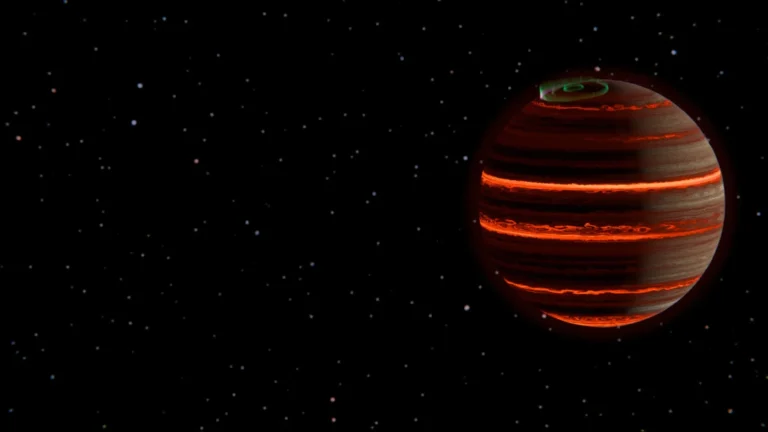
Unveiling the Extreme Weather of SIMP-0136: A Scorching Hot Rogue Planet with Northern Lights-like Activity
In a groundbreaking discovery, astronomers from Trinity College Dublin have utilized the NASA/ESA/CSA James Webb Space Telescope to study the weather of SIMP-0136, a nearby rogue planet, revealing strong auroral activity, extreme temperatures, and surprising cloud coverage. The research, led by Dr. Evert Nasedkin, has provided the most precise measurements of the atmosphere of any extra-solar object to date, shedding light on the planet’s atmospheric properties and weather processes.
The discovery of SIMP-0136’s extreme weather is a significant milestone in the field of exoplanetary science. Who would have thought that a rogue planet, wandering through the vast expanse of space, would exhibit weather patterns similar to those found on Earth? What makes this discovery even more remarkable is the fact that the planet’s atmosphere is being studied in unprecedented detail, thanks to the cutting-edge technology of the James Webb Space Telescope. Where is this planet located? SIMP-0136 is a free-floating planet, meaning it does not orbit a star, and is situated in the vicinity of our solar system. When did this discovery take place? The research was recently published in the leading international journal, Astronomy & Astrophysics, and is the first publication from the new ‘Exo-Aimsir’ group led by Prof. Johanna Vos in Trinity’s School of Physics. Why is this discovery important? The study of SIMP-0136’s atmosphere provides valuable insights into the weather processes that drive the planet’s extreme conditions, and how these processes might apply to other exoplanets. How did the researchers achieve this breakthrough? By using the James Webb Space Telescope to observe minute changes in the planet’s brightness as it rotated, the team was able to track changes in temperature, cloud cover, and chemistry.
Uncovering the Secrets of SIMP-0136’s Atmosphere
The research team, led by Dr. Evert Nasedkin, used the James Webb Space Telescope to observe SIMP-0136’s atmosphere, revealing a range of surprising features. Some of the key highlights of the discovery include:
* Strong auroral activity, similar to the Northern Lights on Earth or the powerful aurora on Jupiter
* Extreme temperatures, reaching over 1,500 °C, making it one of the hottest known planets
* Constant cloud coverage, composed of silicate grains, similar to sand on a beach
* Subtle changes in the chemical composition of the atmosphere, suggestive of storms rotating into view
* Precise measurements of temperature changes, smaller than 5 °C, which is unprecedented for an extra-solar object
The Significance of Auroral Activity
The discovery of strong auroral activity on SIMP-0136 is a significant finding, as it suggests that the planet’s upper atmosphere is being heated by a powerful magnetic field. This is similar to the process that occurs on Jupiter, where the planet’s strong magnetic field heats up its upper atmosphere, creating spectacular aurora displays. According to Dr. Nasedkin, “These are some of the most precise measurements of the atmosphere of any extra-solar object to date, and the first time that changes in the atmospheric properties have been directly measured.”
Cloud Coverage and Atmospheric Chemistry
The research team was surprised to find that the cloud coverage on SIMP-0136 is constant, with no significant changes observed over the surface of the planet. This is in contrast to Earth, where cloud coverage can vary significantly, leading to changes in the atmosphere. The clouds on SIMP-0136 are composed of silicate grains, similar to sand on a beach, which is a result of the planet’s extreme temperatures. As Dr. Nasedkin explained, “Different wavelengths of light are related to different atmospheric features. Similar to observing the changes in color over the surface of the earth, the changes in the color of SIMP-0136 are driven by changes in the atmospheric properties.”
Implications for Exoplanetary Science
The discovery of SIMP-0136’s extreme weather has significant implications for the field of exoplanetary science. According to Prof. Johanna Vos, “This work is exciting because it shows that by applying our state-of-the-art modeling techniques to cutting-edge datasets from JWST, we can begin to piece together the processes that drive weather in worlds beyond our solar system.” The research also highlights the potential for future studies of exoplanetary atmospheres, using next-generation telescopes such as the Extremely Large Telescope and the Habitable Worlds Observatory.
Future Directions
The study of SIMP-0136’s atmosphere is just the beginning of a new era of exoplanetary research. As Prof. Vos noted, “While for now these types of spectroscopic variability observations are limited to isolated brown dwarfs, like this one, future observations with the Extremely Large Telescope and eventually the Habitable Worlds Observatory will enable the study of the atmospheric dynamics of exoplanets, from Jupiter-like gas giants to rocky worlds.” The discovery of SIMP-0136’s extreme weather is a significant step forward in our understanding of the complexities of exoplanetary atmospheres, and will pave the way for future research into the weather processes that drive these distant worlds.
Conclusion: The discovery of SIMP-0136’s extreme weather is a groundbreaking finding that has significant implications for the field of exoplanetary science. The research, led by Dr. Evert Nasedkin, has provided unprecedented insights into the planet’s atmosphere, revealing strong auroral activity, extreme temperatures, and surprising cloud coverage. As we continue to explore the vast expanse of our universe, the study of exoplanetary atmospheres will play a crucial role in our understanding of the complexities of these distant worlds.
Keywords: SIMP-0136, rogue planet, James Webb Space Telescope, exoplanetary science, atmospheric chemistry, auroral activity, cloud coverage, temperature changes, spectroscopic variability, exoplanetary atmospheres, Extremely Large Telescope, Habitable Worlds Observatory.
Hashtags: #ExoplanetaryScience #RoguePlanet #JamesWebbSpaceTelescope #AtmosphericChemistry #AuroralActivity #CloudCoverage #TemperatureChanges #SpectroscopicVariability #ExoplanetaryAtmospheres #ExtremelyLargeTelescope #HabitableWorldsObservatory #SpaceExploration #Astrophysics #Astronomy.
Source link